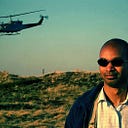Are you one of the Interfacers between technology and social, yesterday and the evolving?
“Imagine standing in Times Square at Night, your eyes and ears stimulated by electronic billboards, street conversations, and the sounds of honking traffic. You are living, breathing and participating in the life of this small island. It is as if you and Times Square have become truly interactive”. The intro to a feature on my views of the web by Jamrock Mag, next to Rhianna, in 2006.
The article continues:
“London-based David Dunkley Gyimah is bringing this kind of your in-your-face immediacy to web junkies. His site viewmagazine is an intoxicating hodgepodge of online, video, audio and print journalism… His format is one that many US outlets would love to emulate. And it is attractive to a demographic that spends more time surfing the web than watching TV”.
Web 2.0 was an exciting time for me. It was a place with no behemoths, where a combination of science fiction and fact could merge. I was previously a maths/chemistry grad, who became a journalist and coded using Flash action script, HTML, CSS and Director Lingo.
That slip stream of the web in 2005 onwards gave rise to a new type of practitioner — one who was creative, artistic, tech minded, could tell stories not based on existing patterns, and had empathetic leadership qualities. They existed at the interface of many disciplines and were easily ill-defined because they’d jump from one medium to another.
Amongst that burgeoning group I found myself in that sub-group. Apple would provide me a platform to speak at their stores. I drew a future via trend extrapolation. Some have come to pass, some yet to happen. They will. The head of Google Europe, the head of digital at the BBC, the US knight Batten Awards jury for Innovation in journalism, the Sunday Times etc referenced in nice ways the vision I shared.
Whilst the people that work within the tech and business interfaces are necessary, the last few years has seen the call for an interfacer 2. Sounds like a science fiction movie again. Bear with me.
Just as web 2,0 and apps saw the need to create API ( Application programming interface) for networks to talk to each other. There’s a need for Human Interfacers to connect people & communities.
But they already exist, you say. They’re negotiators, brokers, consultants to professional services. The DEI manager is an interfacer between a group that is yet to affirm diff cultures and people whose knowledge and experience demands more accountability.
Yet the interfacer I’m referencing builds on the 2005 people I met who encompass a deep understanding of communities, learning, how knowledge is porous and how the dynamics of culture call on different shared solutions.
In his book Range, author David Epstein points to a group of highly respected problem-solvers, who are buoyed not just by experience, and tech solutions, but by wide specialisms and empathy. It’s a pressing skill heading towards 2030 which I spoke to an international group of researcher from Poland about this week, and am due to speak to an academic group interviewing me “because of my contribution to the creative industries”.
So what’s behind this type of interfacing and what’s necessary? That’s what I teach at Masters level in our digital story lab and I’ll share some more in my next post.
Then I was featured in Times Square :)
Article from 2006 -
